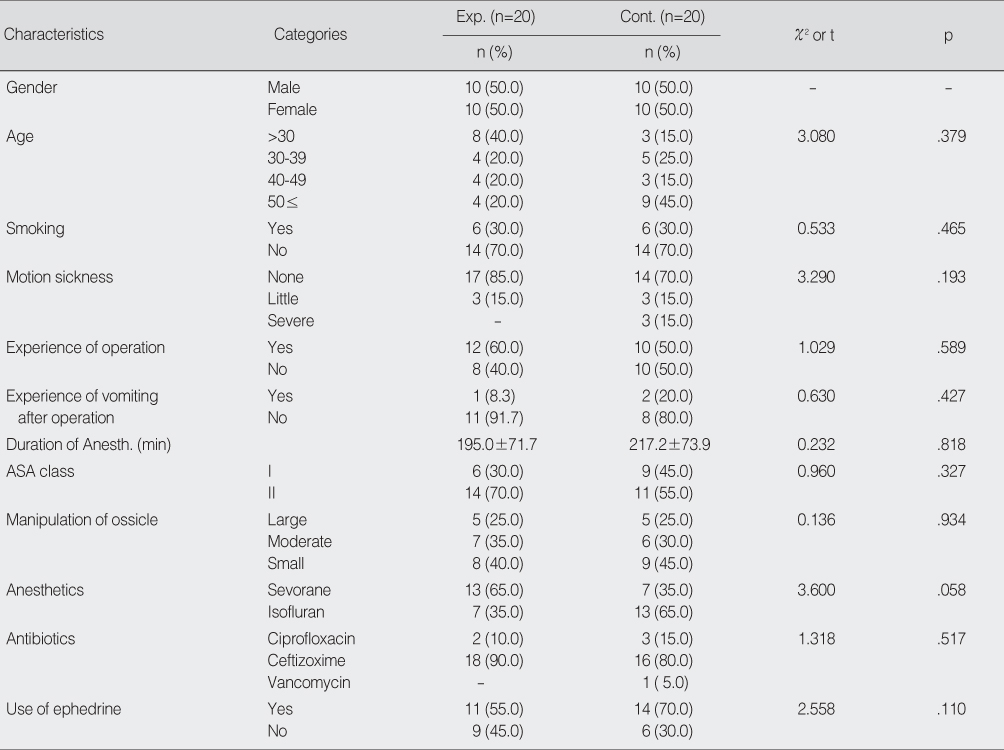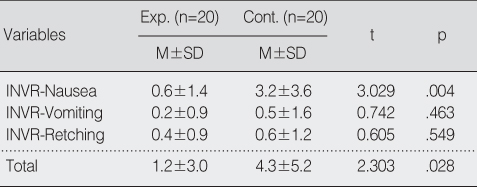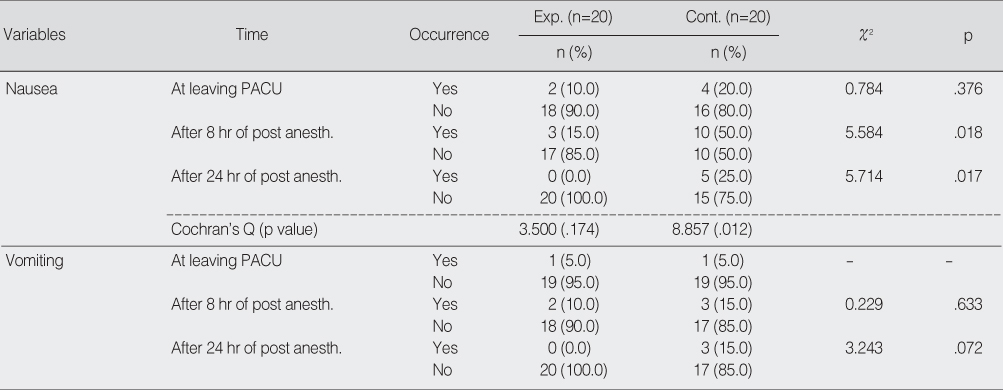Articles
- Page Path
- HOME > J Korean Acad Nurs > Volume 38(4); 2008 > Article
-
Original Article
- Effects of the Nei-Guan Acupressure by Wrist Band on Postoperative Nausea and Vomiting after Middle Ear Surgery
- Myung Yun Lee, Hye Sook Min
-
Journal of Korean Academy of Nursing 2008;38(4):503-512.
DOI: https://doi.org/10.4040/jkan.2008.38.4.503
Published online: August 31, 2008
1Nurse, Department of Nursing, Dong-A University Medical Center, Korea.
2Associate Professor, Department of Nursing, Dong-A University, Busan, Korea.
- Address reprint requests to: Min, Hye-Sook. Department of Nursing, Dong-A University, 1 Dongdaesin-dong 3ga, Seo-gu, Busan 602-714, Korea. Tel: 82-51-240-2872, Fax: 82-51-240-2947, hsmin@dau.ac.kr
Copyright © 2008 Korean Society of Nursing Science
Abstract
-
Purpose
- This study was to identify the effects of Nei-Guan accupressure using a wrist band on postoperative nausea and vomiting after middle ear surgery
-
Methods
- The study design was a nonequivalent control group non-synchronized posttest design. Forty patients were assigned into two groups of 20 patients, the wrist band group and the control group. In the wristband group, acupressure was applied with a wrist band on the P6 point at both wrists from 30 min before to 24 hr after anesthesia.
-
Results
- The 1st hypothesis 'Applied wrist band groups will have a greater reduction in the nausea & vomiting grades by INVR than the control group' was accepted (t=2.303, p=.028). The 2nd hypothesis 'The Applied wrist band groups will have a greater reduction in the occurrence of nausea & vomiting than the control group' was partly accepted. The 3rd hypothesis 'The applied wrist band group will have a greater reduction in injection of antiemetics for 24 hr. post anesthesia than the control group' was rejected.
-
Conclusion
- Acupressure on the P6 point using a wrist band is effective to alleviate nausea for middle ear surgery patients.
- 1. Agarwal A, Pathak A, Gaur A. Acupressure wristbands do not prevent postoperative nausea and vomiting after urological enodscopic surgery. Canadian Journal of Anesthesia. 2002;47:319–324.
- 2. Alkaissi A, Evertsson K, Johnsson VA, Ofenbartl L, Kalman S. P6 acupressure may relieve nausea and vomiting after gynecological surgery: An effectiveness study in 410 women. Canadian Journal of Anesthesia. 2002;49:1034–1039.ArticlePubMedPDF
- 3. Andrews PL. Physiology of nausea and vomiting. British journal of anaesthesia. 1992;69(7):Suppl 1. 2S–19S.ArticlePubMed
- 4. Barsoum G, Perry EP, Fraser IA. Postoperative nausea is relieved by acupressure. Journal of Royal Social Medicine. 1990;83(2):86–89.ArticlePDF
- 5. Choi DH, Ko JS, Ahn HJ, Kim JA. A Korean predictive model for postoperative nausea and vomiting. Journal of Korean Medical Science. 2005;20:811–815.ArticlePubMedPMC
- 6. Choi YH. Effects of P6 acupressure and Korean band accupuncture on chemotherapy-induced nausea, vomiting, and anorexia among cancer patients. 2003;Daegu, Keimyung University. Unpublished doctoral dissertation.
- 7. Cohen J. Statistical power analysis for the behavioral science. 1988;2nd ed. Hillsdale, NJ, Lawrence Erlbaum Association Pub.
- 8. Dundee JW, Yang J. Prolongation of the antiemetic action of P6 acupressure in patients having cancer chemotherapy. Journal of the Royal Society Medicine. 1990;83:360–362.
- 9. Fan CF, Tanhui E, Joshi S, Trivedi S, Hong Y, Shevde K. Acupressure treatment for prevention of postoperative nausea and vomiting. Anesthesia and Analgesia. 1997;84:821–825.ArticlePubMed
- 10. Ghaly R.G., Fitzpatrick KT, Dundee JW. Antiemetic studies with traditional Chinese acupucture. A comparison of manual needling with electrical stimulation and commonly used antiemetics. Anaesthesia. 1987;42:1108–1110.ArticlePubMed
- 11. Jang YS, Kim SC, Hong JT, Ok SY, Kim SI. Transcutaneous electrical stimulation of the P6 acupoint reduces postoperative nausea and vomiting after laparoscopic cholecystectomy. Korean Journal of Anesthesiology. 2003;44:853–859.Article
- 12. Kim EJ. Effects of NeiGuan acupressure by wrist band on chemotherapy-related nausea and vomiting in patients with liver cancer. 2007;Seoul, Yonsei University. Unpublished master's thesis.
- 13. Kim JS, Choi HY, Park CH, Na HW, Hong SS. Effects of the Nei-Guan acupressure by wrist band on post operative nausea and vomiting after thyroidectomy. Clinical Nursing Research. 2007;13:79–89.
- 14. Kim YJ, Kim JY, Choi IR, Kim MW, Rhodes V. The index of nausea, vomiting, and retching. Journal of Korean Academy of Adult Nursing. 2000;12:278–285.
- 15. Kovac AL. Prevention and treatment of postoperative nausea and vomiting. Drugs. 2000;59:213–243.ArticlePubMed
- 16. Lee A, Done ML. The use of nonpharmacologic techniques to prevent postoperative nausea and vomiting. A meta-analysis. The use of nonpharmacologic techniques to prevent postoperative nausea and vomiting: A meta-analysis. Anesthesia and Analgesia. 1999;88:1362–1369.PubMed
- 17. Lee GH. Effects of Nei-Guan acupressure on chemotherapy-related nausea and vomiting in patients with ovarian cancer. 2002;Seoul, Yonsei University. Unpublished master's thesis.
- 18. Macario A, Weinger M, Truong P, Lee M. Which clinical anesthesia outcomes are both common and important to avoid? The perspective of a panel of expert anesthesiologists. Anesthesia and Analgesia. 1999;88:1085–1091.ArticlePubMed
- 19. Mann E. Using acupressure and acupuncture to treat postoperative emesis. Professional Nurse. 1999;14:691–694.PubMed
- 20. Ming JL, Kuo BI, Lin JG, Lin LC. The efficacy of acupressure to prevent nausea and vomiting in post-operative patients. Journal of Advanced Nursing. 2002;39:343–351.ArticlePubMed
- 21. National Institute of Health (NIH) consensus conference. Acupunture. Journal of American Medicine Association. 1998;280:518.
- 22. Norris CM. Norris CM. Nausea and vomiting. In: Concept clarification in nursing. 1982;Rockville, MD, Aspeu. 8–11.
- 23. Palazzo MG, Strunin L. Anesthesia and emesis. I. Etiology. Canadian Anaesthetist's Society Journal. 1984;31:178–187.
- 24. Rhodes VA, McDaniel RW. The index of nausea, vomiting and retching a new format of the index of nausea and vomiting. Oncology Nursing Forum. 1999;26:889–894.PubMed
- 25. Roscoe JA, Morrow GR, Hickok JT, Bushunow P, Pierce HI, Flynn PJ, et al. The efficacy of acupressure and acustimulation wrist bands for the relief of chemotherapy induced nausea and vomiting. A University of Rochester Cancer Center Community Clinical Oncology Program multicenter study. Journal of Pain and Symptom Management. 2003;26:731–742.ArticlePubMed
- 26. Shin HS, Song YA. The effect of P6 acupressure for symptom control in pregnant women having hyperemesis gravidarum. Journal of Korean Academy of Nursing. 2005;35:593–601.ArticlePubMedPDF
- 27. Sin CH. Effect of PCA education and P6 acupressure on post operative pain, nausea and vomiting of hysterectomy patient. 2004;Jinju, Gyeongsang National University. Unpublishedmaster's thesis.
- 28. Sin MS. Effect of acupressure on nausea and vomiting during chemotherapy in postoperative stomach cancer patient. 2002;Daejeon, Daejeon University. Unpublished master's thesis.
- 29. Stoeling RK. Pharmacology and physiology in anesthetic practice. 1987;Philadelphia, PA, J. B. Lippincott.
- 30. Strong TH Jr. Alternative therapies of morning sickness. Clinical Obstetrics and Gynecology. 2001;44:653–660.ArticlePubMed
- 31. White PF. Are nonpharmacological techniques useful alternative to antiemetic drugs for the prevention of nausea and vomiting? Anesthesia and Analgesia. 1997;84:712–714.PubMed
REFERENCES
Figure & Data
REFERENCES
Citations

- Comparing Effects of Two Different Types of Nei-Guan Acupuncture Stimulation Devices in Reducing Postoperative Nausea and Vomiting
Hanna Oh, Bo Hwan Kim
Journal of PeriAnesthesia Nursing.2017; 32(3): 177. CrossRef - Efficacy of Nei-Guan acupressure on Nausea and Vomiting in Patients undergoing laparoscopic prostatectomy with Intravenous Patient Controlled Analgesia
Mi Young Shin, Ju Young Ha
Journal of Korean Academy of Fundamentals of Nursing.2014; 21(2): 131. CrossRef - Effects of Nei-Guan Acupressure on Nausea, Vomiting and Level of Satisfaction for Gynecological Surgery Patients Who Are Using a Patient-Controlled Analgesia
Nam Cho Kim, Je Bog Yoo, Myung Sook Cho, Eun Ju Shin, Tae Soo Hahm
Journal of Korean Academy of Nursing.2010; 40(3): 423. CrossRef

Figure 1
Homogeneity Test for Characteristics of Subjects (N=40)
Anesth.=anesthesia; ASA=American Society of Anesthesiology; Exp.=experimental group; Cont.=control group.
Group Comparisons in Nauea and Vomiting using INVR between Experimental and Control Group (N=40)
INVR=Index of Nausea, Vomiting and Retching.
Group Comparisons in Occurrence of Nauea and Vomiting between Experimental and Control Group (N=40)
PACU=post anesthesia care unit; anesth.=anesthesia.
Group Comparisons in Injection of Antiemetics between Experimental and Control Group (N=40)
Anesth.=anesthesia; ASA=American Society of Anesthesiology; Exp.=experimental group; Cont.=control group.
INVR=Index of Nausea, Vomiting and Retching.
PACU=post anesthesia care unit; anesth.=anesthesia.
 KSNS
KSNS
 E-SUBMISSION
E-SUBMISSION





 Cite
Cite

